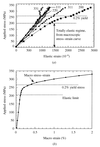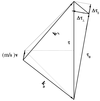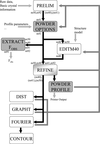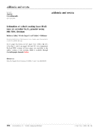issue contents
June 2001 issue

Cover illustration: Diffuse scattering around a 200 Bragg peak from a Cu-Ti single crystal (the intensities are in ln scale, the plane is (001), with the [100] direction horizontal, and the Bragg peak is masked by the blue beam stop). Courtesy of O. Lyon, C. Servant & J. P. Simon [J. Appl. Cryst. (2000), 33, 928-937].
research papers
Download citation


Download citation


The first X-ray study of the metastable states of a spin-crossover compound is presented, including spin transition without volume change.
String Fit is a novel molecular-structure-oriented neutron and X-ray reflectivity analysis method.
A procedure for computing the resolution function for a time-of-flight diffractometer with curved slits chopper, using the matrix computation technique, is presented.
Thermal neutron transmission measurements have been made as a function of wavelength on a pyrolytic graphite monochromator crystal that has been set to diffract a horizontal beam at different take-off angles. With respect to multi-instrument beamline design, the data show that it is best for a monochromator with the greatest (horizontal) take-off angle to be placed upstream, while monochromators with decreasing take-off angles should be placed progressively further downstream.
This paper describes a method for the calculation of a stress-free lattice parameter from the analysis of diffraction data, utilizing the elastic anisotropy of a stressed material. The technique is demonstrated using data from a uniaxial load test.
A refinement strategy based on a bivariate analysis with a stepwise truncation of low-order reflection data and a rejection of outliers (LOT analysis), which had successfully been applied to X-ray single-crystal data, is applied to Rietveld refinements. Model calculations and refinements show an improvement in the determination of the site occupancy factors when the LOT strategy is used.
Some improvements are proposed for the statistical analysis of orientation data within individual grains, in particular by allowing for crystallographic symmetries. A method based on quaternions is then presented to characterize orientation spreads including anisotropic effects.
The Bragg edges appearing in time-of-flight neutron transmission experiments of polycrystalline materials are used to define lattice parameters precisely. The technique is specially suited for very fast characterization of bulk samples as well as for mapping spatial changes in the lattice parameter and hence the strain in engineering samples.
Two different methods of diffraction peak profile analysis are suggested for the determination of microstructural parameters in terms of crystallite size distribution and dislocation structure. The first is based on modified Williamson–Hall and Warren–Averbach procedures; the second is a whole-profile fitting by using the Fourier coefficients of ab initio size and strain profiles.
The new diffractometer is devoted to the detection of phase transitions, to the determination of thermal expansion curves and to the study of kinetic chemical reactions in situ. The apparatus has been tested by measuring the cell parameter of the standard material cubic Na2Ca3Al2F14 in the 90–600 K range, and by measuring the thermal expansion of the cell parameter of cubic AgI in the 303–553 K range, revealing a first-order phase transition.
A novel method for the estimation of the background in a powder diffraction pattern has been developed using a robust Bayesian analysis. The underlying probability theory is discussed in terms of going beyond the Gaussian approximation normally associated with counting statistics and least-squares analysis, and various examples are presented that illustrate the general applicability of the approach.
The fit of a set of simulated noisy EXAFS (extended X-ray absorption fine structure) spectra can be used to sample the frequency distribution of structural parameters and provide their statistical estimators (mean, dispersion, correlations).
A systematic study of the application of collimating and slightly focusing polycapillary optics to the X-ray crystallographic structure determination of egg-white lysozyme using two different sources, a standard rotating anode source and a low-power table-top microfocusing source, is presented.
The complicated inverse scattering problem of reconstructing depth-dependent lattice parameters from high-resolution X-ray diffraction spectra is analysed by using neural networks. Attention is paid to the practically important case of structural modifications in the near-surface layers of ion-implanted single crystals.
Neutron imaging with bent crystals is considered in the linear approximation of neutron optics. A matrix formalism analogous to that of conventional lens optics is developed.
The possibility of extending the Rietveld method to incorporate textured polycrystalline materials is demonstrated with a zircaloy sample. By assigning the pole densities obtained by separate texture analysis to the preferred orientation factors in the mathematical model of the Rietveld method, good profile refinement results are achieved with the neutron diffraction patterns.
cryocrystallography papers
The feasibility of growing isolated protein crystals inside X-ray capillaries from gelled solutions of proteins has been demonstrated experimentally. Using these same X-ray capillaries, X-ray diffraction data were collected at both room temperature and 100 K.
teaching and education
Free 

New academic courses for teaching protein crystallography to biology and chemistry students have been developed. They include model-building exercises using adapted general-purpose kits and application of Web tools for practical classes and for conducting educational/examination quizzes.
short communications
A citation analysis of papers published by the CCDC for the period 1981–1998 shows rapidly increasing citation frequencies over time, over journals and over geographical regions. The ten most highly cited papers, comprising database descriptions, geometrical tabulations and basic research papers, together received an average of 1058 citations per annum over the period 1995–1998.
An X-ray powder diffraction profile analysis of ball-milled ceramic vanadium pentoxide samples reveals the development of nanostructure with significant plastic strain and its confinement.
An algorithm for the optimization of data collection is described. The algorithm ensures optimum quality of measurements at the set survey rate and operates efficiently and simply by the flexible distribution of time between first and second measurements of a reflection.
A simple innovation of the conventional vapor-diffusion method, involving the introduction of a capillary barrier (for hanging drop) or a punched film barrier (for sitting drop), has been set up. Crystallization experiments showed that this modified vapor-controlling-diffusion method is very effective for producing large protein crystals.
computer programs
The program Quanto is described; it is devoted to quantitative phase analysis of polycrystalline samples by means of the Rietveld method.
A new version of the computer program JANA is introduced that allows Rietveld refinements of periodic and aperiodic crystal structures. Applications to (CO)xC60 and the incommensurately modulated structure of NbTe4 are presented.
computer program abstracts
The program TWIN3.0 is intended to test single-crystal data sets for the possible existence of twinning by merohedry.
addenda and errata
Free 



 journal menu
journal menu














































